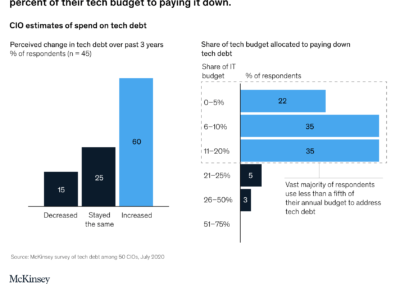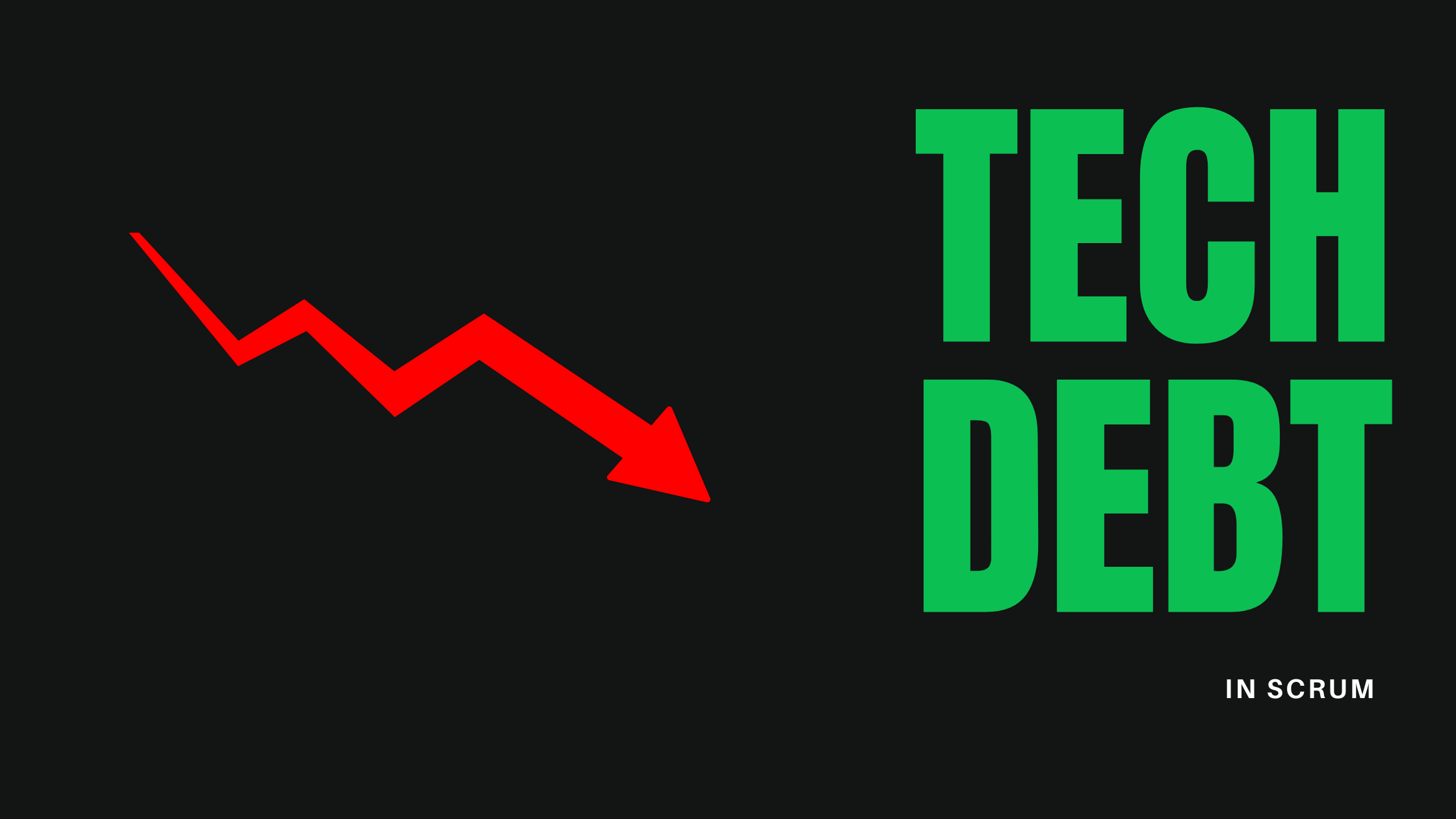Elimination of technical debt and explain technical debt. Tech debt common causes.
Understanding Technical Debt
Technical debt is a concept in software development that reflects the implied cost of additional rework caused by choosing an easy or quick solution now instead of using a better approach that would take longer. In e-commerce software, technical debt can accumulate rapidly due to the fast-paced nature of online retail and the constant pressure to implement new features and meet delivery deadlines.
Definition of Technical Debt
Ward Cunningham, one of the authors of the Agile Manifesto, first coined the term “technical debt” in 1992. He explained it with an analogy to financial debt: “Shipping first time code is like going into debt. A little debt speeds development so long as it is paid back promptly with a rewrite… The danger occurs when the debt is not repaid. Every minute spent on not-quite-right code counts as interest on that debt.”
Explain Technical Debt
Technical debt can be thought of as the gap between the current state of a codebase and its ideal state. It represents the extra work that needs to be done in the future to fix the shortcuts taken during the initial development. Like financial debt, technical debt accumulates interest over time, making the software harder to maintain and extend.
Tech Debt
Tech debt, a shorthand for technical debt, is a pervasive issue in software engineering, especially in rapidly evolving fields like e-commerce. It can manifest in various forms, from outdated software architecture to poorly documented code.
Types of Technical Debt
- Code Debt: This refers to issues within the codebase itself, such as duplicated code, overly complex functions, or lack of proper documentation.
- Design Debt: This occurs when the software’s design doesn’t align with current requirements or best practices.
- Test Debt: This happens when there’s insufficient testing coverage or when tests are of poor quality.
- Documentation Debt: This refers to missing, outdated, or inadequate documentation.
- Infrastructure Debt: This involves using outdated or sub-optimal hardware, software platforms, or development tools.
Tech Debt Bad?
While some level of technical debt is often unavoidable, excessive tech debt can be detrimental to an e-commerce business. It can slow down development, increase the likelihood of bugs, and make it difficult to implement new features or scale the system. However, it’s important to note that not all technical debt is bad. Sometimes, taking on a calculated amount of technical debt can speed up development and allow a business to meet crucial deadlines or capitalize on market opportunities.
Common Causes
Understanding the common causes of technical debt is crucial for preventing its accumulation. Some of the most frequent sources include:
- Time Pressure: Developers often take shortcuts to meet tight deadlines, leading to sub-optimal solutions.
- Lack of Alignment Between Business and Technical Teams: When business needs are not effectively communicated to the development team, it can result in solutions that don’t fully address the requirements.
- Outdated Technology: Failing to update frameworks, libraries, or platforms can lead to compatibility issues and security vulnerabilities.
- Poor Code Quality: Lack of adherence to coding standards, insufficient code reviews, and inadequate testing can all contribute to technical debt.
- Changing Requirements: Frequent changes in project requirements without corresponding updates to the underlying architecture can result in a mismatch between design and implementation.
- Knowledge Silos: When knowledge is concentrated among a few team members, it can lead to inconsistencies in code quality and design decisions.
Agile and Technical Debt
The Agile methodology, widely used in software development, recognizes the reality of technical debt and provides frameworks for managing it effectively.
Agile Definition of Technical Debt
In the context of Agile development, technical debt is often viewed as a tradeoff between speed and quality. Agile teams may consciously decide to take on some technical debt to deliver features quickly, with the understanding that they will need to “pay it back” in future iterations.
Agile Teams and Technical Debt
Agile practices can help manage technical debt in several ways:
- Regular Refactoring: Agile methodologies encourage continuous improvement of the codebase through refactoring.
- Sprint Retrospectives: These provide opportunities to discuss and plan for addressing technical debt.
- Backlog Management: Technical debt items can be added to the product backlog and prioritized alongside new features.
- Continuous Integration and Automated Testing: These practices help identify issues early and prevent the accumulation of debt.
Developer Role in Managing Technical Debt
Developers play a crucial role in both preventing and addressing technical debt. Here are some key responsibilities:
- Writing Clean Code: Adhering to coding standards and best practices can prevent the introduction of new technical debt.
- Refactoring: Regularly improving existing code without changing its external behavior helps keep the codebase maintainable.
- Code Reviews: Participating in and conducting thorough code reviews can catch potential issues before they become entrenched.
- Continuous Learning: Staying updated with new technologies and best practices helps prevent the accumulation of design debt.
- Communicating with Stakeholders: Developers should effectively communicate the implications of technical debt to product managers and other stakeholders.
Reduce Technical Debt
Reducing technical debt requires a concerted effort from the entire development team and support from management. Here are some strategies:
- Prioritize Debt Reduction: Allocate time in each sprint or development cycle specifically for addressing technical debt.
- Implement a Boy Scout Rule: Encourage developers to leave the code a little better than they found it each time they work on it.
- Use Static Code Analysis Tools: These can help identify potential issues in the codebase automatically.
- Improve Documentation: Ensure that code, APIs, and system architecture are well-documented.
- Upgrade and Standardize: Regularly update frameworks and libraries, and standardize technologies across projects where possible.
- Implement Automated Testing: Comprehensive test suites can catch regressions and make refactoring safer.
Manage and Reduce Technical Debt
Managing technical debt is an ongoing process that requires commitment from both the development team and business stakeholders. Here are some approaches:
- Create a Technical Debt Register: Maintain a list of known technical debts, their impact, and estimated cost to fix.
- Use the Technical Debt Quadrant: Categorize debt into reckless/prudent and deliberate/inadvertent to prioritize what to address first.
- Set Debt Thresholds: Establish metrics for acceptable levels of technical debt and take action when these thresholds are exceeded.
- Include Technical Debt in the Definition of Done: Make addressing related technical debt a part of completing any new feature.
- Educate Stakeholders: Help product managers and business leaders understand the importance of managing technical debt.
- Plan for Debt Reduction: Include technical debt reduction as part of the product roadmap and sprint planning.
Bad Code and Technical Debt
While not all technical debt is a result of bad code, poorly written code is a significant contributor to technical debt. Bad code can take many forms:
- Duplicate Code: Violates the DRY (Don’t Repeat Yourself) principle and makes maintenance difficult.
- Overly Complex Functions: Makes code hard to understand and modify.
- Lack of Comments: Makes it difficult for other developers (or the original developer after some time) to understand the code’s intent and context.
- Tight Coupling: Makes the system rigid and hard to change.
- Inconsistent Naming Conventions: Makes the code less readable and maintainable.
Addressing bad code often involves refactoring, which is the process of restructuring existing code without changing its external behavior. Regular refactoring can help keep the codebase clean and prevent the accumulation of technical debt.
Conclusion
Technical debt is an inevitable part of software development, especially in fast-paced environments like e-commerce. While some technical debt can speed up development in the short term, if left unchecked, it can significantly impede progress and increase costs in the long run.
Managing technical debt requires a balanced approach. It involves making conscious decisions about when to take on debt, regularly allocating time for debt reduction, and fostering a culture of code quality within the development team.
By understanding the nature of technical debt, its causes, and strategies for managing it, e-commerce businesses can maintain the agility needed to respond to market demands while ensuring the long-term health and scalability of their software systems.
Remember, the goal isn’t to eliminate all technical debt—that’s often impractical—but to manage it effectively, ensuring that it doesn’t grow to levels that hinder business goals or development productivity. With the right strategies and commitment, technical debt can be kept in check, allowing e-commerce platforms to evolve and thrive in the competitive digital marketplace.













